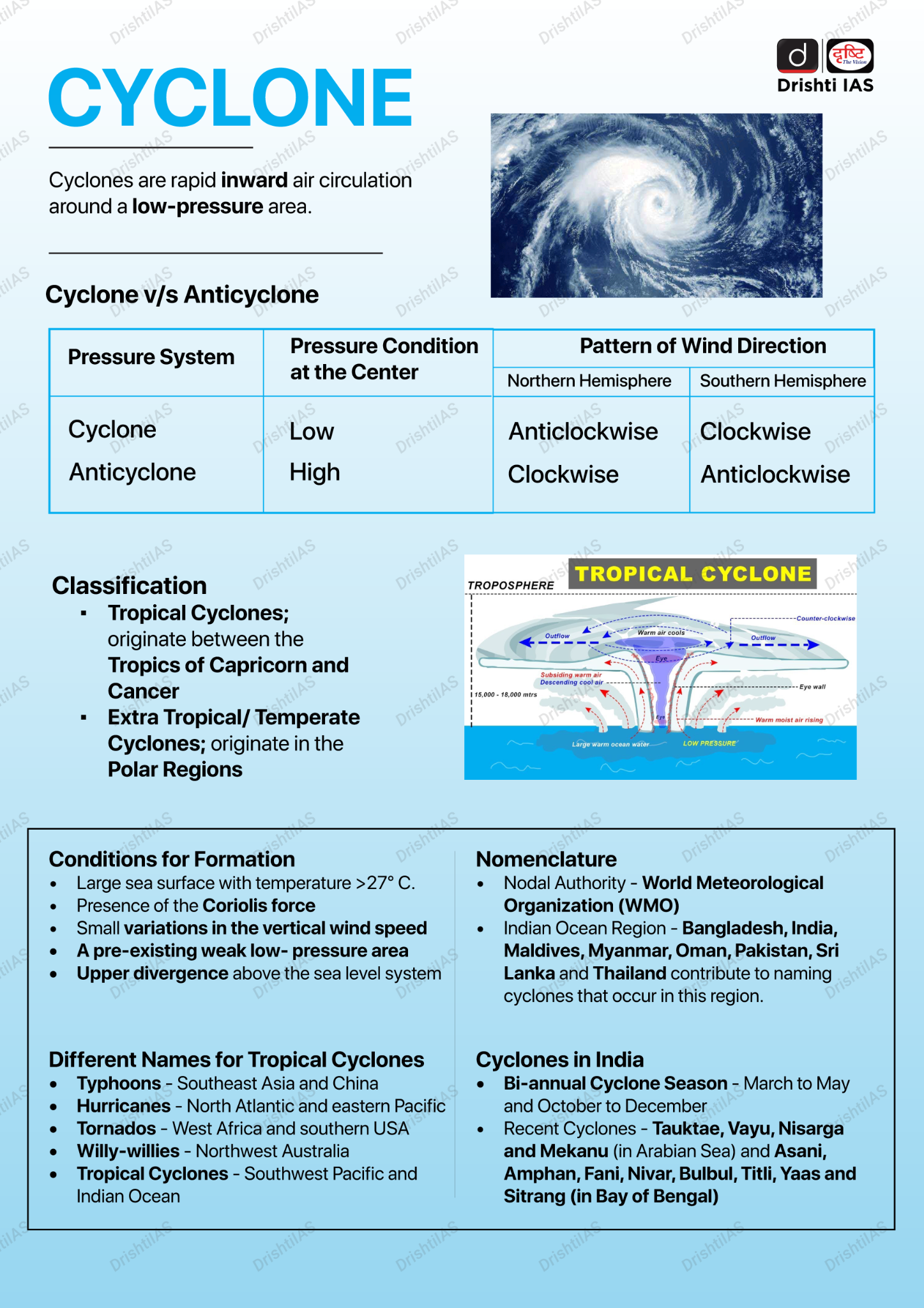Geography
More Frequent Cyclones in Eastern Arabian Sea
- 09 Oct 2023
- 6 min read
For Prelims: Tropical Cyclones (TC), Arabian Sea, Indian Ocean Dipole (IOD), El Nino.
For Mains: More Frequent Cyclones in the Eastern Arabian Sea, Environmental pollution and degradation, Salient features of the world’s physical geography, Important Geophysical phenomena such as earthquakes, Cyclones etc, Changes in critical geographical features and in flora and fauna and the effects of such changes.
Why in News?
Recently, a study has been published in the Nature Journal, which highlights the concerns related to Climate Change causing frequent Tropical Cyclones (TC) in the Eastern Arabian Sea.
- The study is part of the "Forecasting with Fisher's" project, by the Advanced Centre for Atmospheric Radar Research (ACARR) at Cochin University of Science and Technology (CUSAT).
What are the Key Findings of the Study?
- Increasing Frequency and Severity of Cyclones:
- Changes in ocean and atmosphere warming patterns are leading to more frequent and severe tropical cyclones in the Eastern Arabian Sea, adjacent to India’s west coast.
- Typically, tropical cyclones in the Arabian Sea occur at the start of the southwestern monsoon between March and June, as well as after the season, between October and December.
- The Arabian Sea accounts for about 2% of the annual global mean of tropical cyclones but poses a considerable threat due to its densely populated coastlines.
- Changes in ocean and atmosphere warming patterns are leading to more frequent and severe tropical cyclones in the Eastern Arabian Sea, adjacent to India’s west coast.
- Impact of Indian Ocean Dipole (IOD):
- The positive phase of IOD, where one part of the ocean gets warmer than the other, leads to warmer sea surface temperatures and increased precipitation in the western Indian Ocean region.
- IOD, sometimes referred to as the Indian Nino, is similar to the El Nino phenomenon, occurring in the relatively smaller area of the Indian Ocean between the Indonesian and Malaysian coastline in the east and the African coastline near Somalia in the west.
- The positive phase of IOD, where one part of the ocean gets warmer than the other, leads to warmer sea surface temperatures and increased precipitation in the western Indian Ocean region.
- Anthropogenic Influence:
- The recent increase in the frequency of extremely severe cyclonic storms over the Arabian Sea during the post-monsoon season is attributed to anthropogenic (human-caused) influence rather than natural variability.
- Human-induced climate change is contributing to the intensification and higher frequency of cyclones in the Arabian Sea.
- Impact on Western Indian Coastline:
- The intensification and increase in cyclone frequency pose a significant threat to the densely populated coastal regions along the western coast of India, from Gujarat to Thiruvananthapuram, facing higher risks, including strong winds, storm surges, heavy rainfall, and other associated hazards.
- Concerns for Coastal Communities:
- The changing cyclone patterns are expected to significantly affect the lives and livelihoods of indigenous coastal communities and artisanal fishers, necessitating a need for further studies and adaptation strategies.
- Recommendations:
- The study calls for changes in development strategies to account for increased cyclone risks and emphasizes the need for updated policies and technologies related to storm warnings and localized weather services.
What are Cyclones?
Note
- Cyclones in the Bay of Bengal (BOB) are relatively more frequent and intense than those of the Arabian Sea.
- The Bay of Bengal typically sees multiple cyclonic events during the tropical cyclone season, which is primarily from April to December.
- The BOB usually has higher sea surface temperatures, especially during the pre-monsoon and post-monsoon seasons, providing the necessary energy and moisture for cyclone formation and intensification.
- The convergence of winds in the BOB, combined with the Coriolis Force (resulting from the Earth's rotation), creates an environment suitable for cyclone genesis. These converging winds form areas of low pressure, which can develop into tropical disturbances and cyclones.
UPSC Civil Services Examination Previous Year Question (PYQ)
Prelims
Q. Consider the following statements: (2020)
- Jet streams occur in the Northern Hemisphere only.
- Only some cyclones develop an eye.
- The temperature inside the eye of a cyclone is nearly 10ºC lesser than that of the surroundings.
Which of the statements given above is/are correct?
(a) 1 only
(b) 2 and 3 only
(c) 2 only
(d) 1 and 3 only
Ans: (c)
Q. In the South Atlantic and South-Eastern Pacific regions in tropical latitudes, cyclone does not originate. What is the reason? (2015)
(a) Sea surface temperatures are low
(b) Inter-Tropical Convergence Zone seldom occurs
(c) Coriolis force is too weak
(d) Absence of land in those regions
Ans: (b)
Mains:
Q. Tropical cyclones are largely confined to the South China Sea, Bay of Bengal and Gulf of Mexico. Why? (2014)







